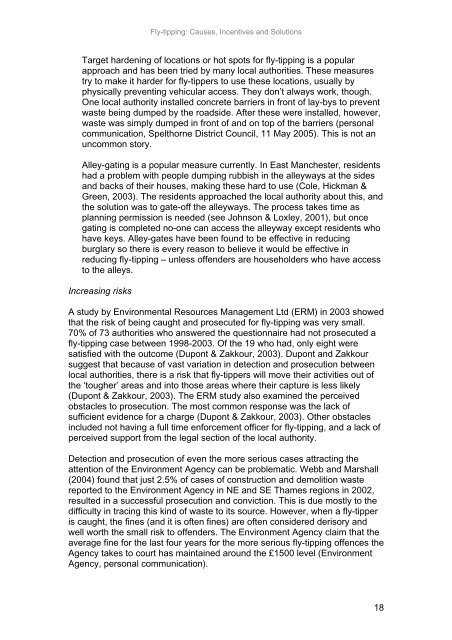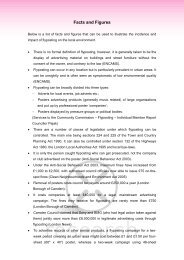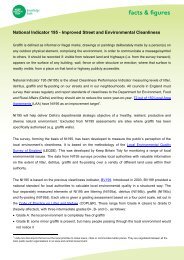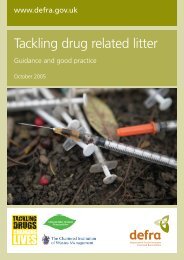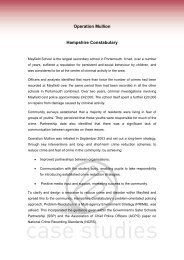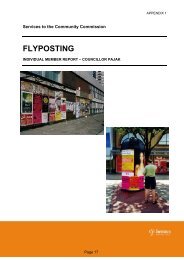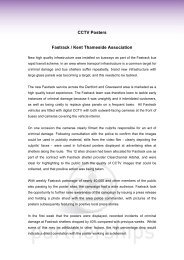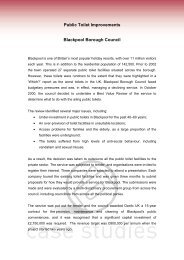Fly-tipping: Causes, Incentives and Solutions - Keep Britain Tidy
Fly-tipping: Causes, Incentives and Solutions - Keep Britain Tidy
Fly-tipping: Causes, Incentives and Solutions - Keep Britain Tidy
You also want an ePaper? Increase the reach of your titles
YUMPU automatically turns print PDFs into web optimized ePapers that Google loves.
<strong>Fly</strong>-<strong>tipping</strong>: <strong>Causes</strong>, <strong>Incentives</strong> <strong>and</strong> <strong>Solutions</strong><br />
Target hardening of locations or hot spots for fly-<strong>tipping</strong> is a popular<br />
approach <strong>and</strong> has been tried by many local authorities. These measures<br />
try to make it harder for fly-tippers to use these locations, usually by<br />
physically preventing vehicular access. They don’t always work, though.<br />
One local authority installed concrete barriers in front of lay-bys to prevent<br />
waste being dumped by the roadside. After these were installed, however,<br />
waste was simply dumped in front of <strong>and</strong> on top of the barriers (personal<br />
communication, Spelthorne District Council, 11 May 2005). This is not an<br />
uncommon story.<br />
Alley-gating is a popular measure currently. In East Manchester, residents<br />
had a problem with people dumping rubbish in the alleyways at the sides<br />
<strong>and</strong> backs of their houses, making these hard to use (Cole, Hickman &<br />
Green, 2003). The residents approached the local authority about this, <strong>and</strong><br />
the solution was to gate-off the alleyways. The process takes time as<br />
planning permission is needed (see Johnson & Loxley, 2001), but once<br />
gating is completed no-one can access the alleyway except residents who<br />
have keys. Alley-gates have been found to be effective in reducing<br />
burglary so there is every reason to believe it would be effective in<br />
reducing fly-<strong>tipping</strong> – unless offenders are householders who have access<br />
to the alleys.<br />
Increasing risks<br />
A study by Environmental Resources Management Ltd (ERM) in 2003 showed<br />
that the risk of being caught <strong>and</strong> prosecuted for fly-<strong>tipping</strong> was very small.<br />
70% of 73 authorities who answered the questionnaire had not prosecuted a<br />
fly-<strong>tipping</strong> case between 1998-2003. Of the 19 who had, only eight were<br />
satisfied with the outcome (Dupont & Zakkour, 2003). Dupont <strong>and</strong> Zakkour<br />
suggest that because of vast variation in detection <strong>and</strong> prosecution between<br />
local authorities, there is a risk that fly-tippers will move their activities out of<br />
the ‘tougher’ areas <strong>and</strong> into those areas where their capture is less likely<br />
(Dupont & Zakkour, 2003). The ERM study also examined the perceived<br />
obstacles to prosecution. The most common response was the lack of<br />
sufficient evidence for a charge (Dupont & Zakkour, 2003). Other obstacles<br />
included not having a full time enforcement officer for fly-<strong>tipping</strong>, <strong>and</strong> a lack of<br />
perceived support from the legal section of the local authority.<br />
Detection <strong>and</strong> prosecution of even the more serious cases attracting the<br />
attention of the Environment Agency can be problematic. Webb <strong>and</strong> Marshall<br />
(2004) found that just 2.5% of cases of construction <strong>and</strong> demolition waste<br />
reported to the Environment Agency in NE <strong>and</strong> SE Thames regions in 2002,<br />
resulted in a successful prosecution <strong>and</strong> conviction. This is due mostly to the<br />
difficulty in tracing this kind of waste to its source. However, when a fly-tipper<br />
is caught, the fines (<strong>and</strong> it is often fines) are often considered derisory <strong>and</strong><br />
well worth the small risk to offenders. The Environment Agency claim that the<br />
average fine for the last four years for the more serious fly-<strong>tipping</strong> offences the<br />
Agency takes to court has maintained around the £1500 level (Environment<br />
Agency, personal communication).<br />
18


